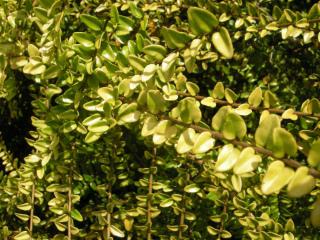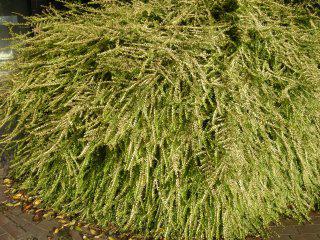
Lonicera nitida 'Baggesens Gold' detail (03/12/2011, London)
Position: Full sun to partial shade
Flowering Period: Summer
Soil: Well drained, moist
Eventual Height: 1.5m
Eventual Spread: 1.5m
Hardiness: USDA 6b – 9b
Family: Caprifoliaceae
Lonicera nitida ‘Baggesen’s Gold’ is a small dense, fast growing evergreen shrub with a bushy growth habit. The glossy leaves of the plant are ovate in shape, are 6 -16mm long and yellow in color. The leaves are bright yellow in summer fading to yellow/ green in winter. The flowers are creamy white, fragrant, 6mm long and they grow in pairs, they are two lipped flowers, often very fragrant. The fruit is an inedible, bluish/ purple berry about 6mm in diameter. The stems of the plant are layered one on top of the other giving the appearance of a haystack.
Lonicera nitida ‘Baggesen’s Gold’ is commonly known as Shrubby honeysuckle, Boxleaf Honeysuckle or Wilson’s Honeyscukle. This species, Lonicera nitida, is native to south west China. It grows in scrub form along streams at 1200 to 3000m. This plant is often used as a bonsai. The common name Wilson’s Honeysuckle was named after the celebrated plant hunter Ernest Henry Wilson, the first European to find it. L. nitida has been introduced into Western cultivation twice. The first clone, which arrived in 1908 never flowers, but the second available since 1939 flowers freely. L. nitida ‘Baggesen’s Gold’ was introduced by J.H. Baggesen of Kent, England, in 1967.
The etymological root of the binomial name Lonicera is named after a German naturalist, Adam Lonitzer, of the 16th century. Nitida is derived from the Latin nitidus ’shining’ or ‘bright’, referring to the leaves.

Lonicera nitida 'Baggesens Gold' (03/12/2011, London)
The landscape architect may find Lonicera nitida ‘Baggesen’s Gold’ useful as a robust ground cover plant and is particularly useful when planted en mass when low maintenance is required. It may be used as a dense hedging plant. It is drought tolerant once established and will tolerate maritime conditions.
Ecologically, this plant attracts birds for its fruit and small birds use its dense habit for nesting. Insects to pollinate its flowers.
The Royal Horticultural Society has given L.nitida ‘Baggesens Gold’ their it prestigious award of Garden Merit in 1993.
L.nitida ‘Baggesens Gold’ prefers most fertile well drained soils. It will tolerate most pH of soils, including chalky.
Maintenance: This plant requires little maintenance. If maintained as a hedge, it should be clipped three times a year to maintain its shape.

